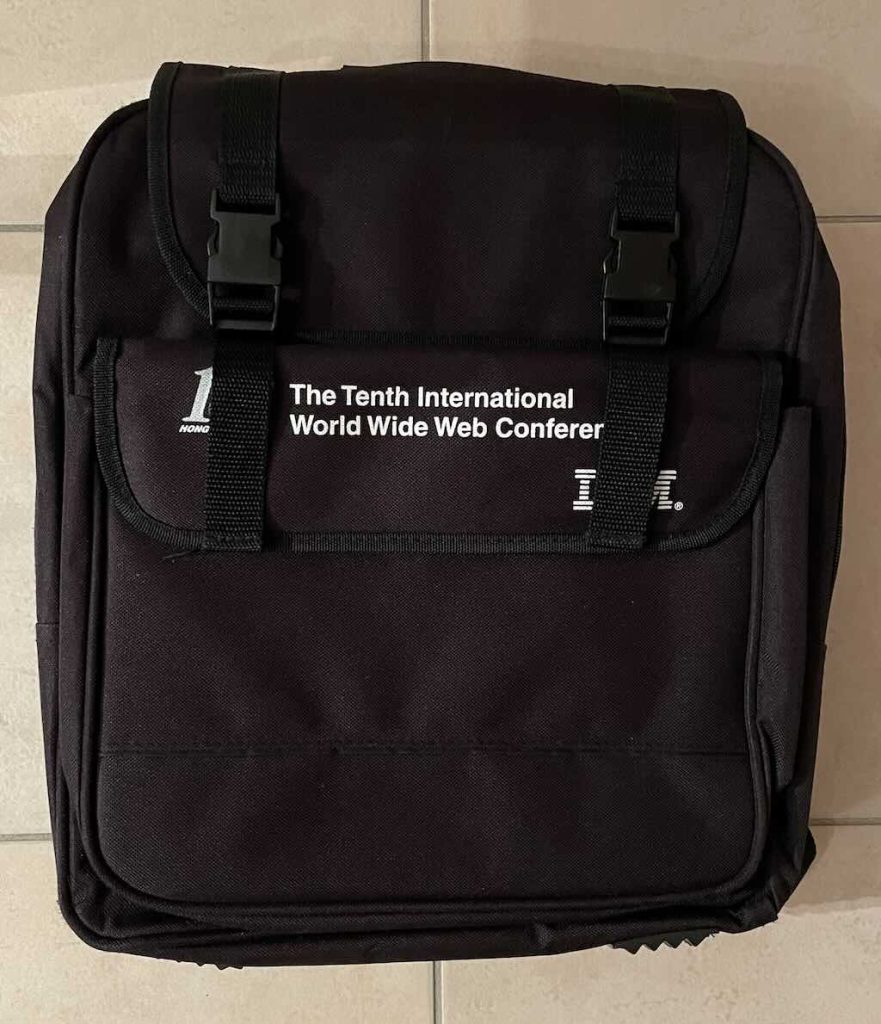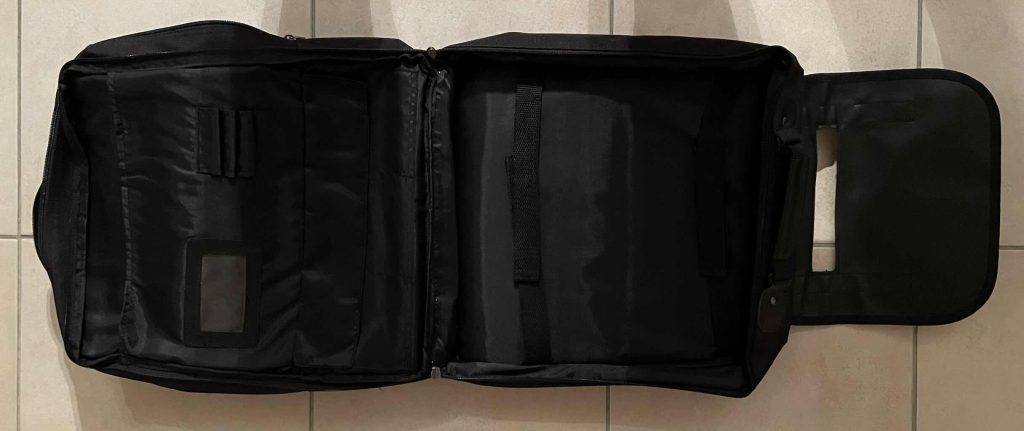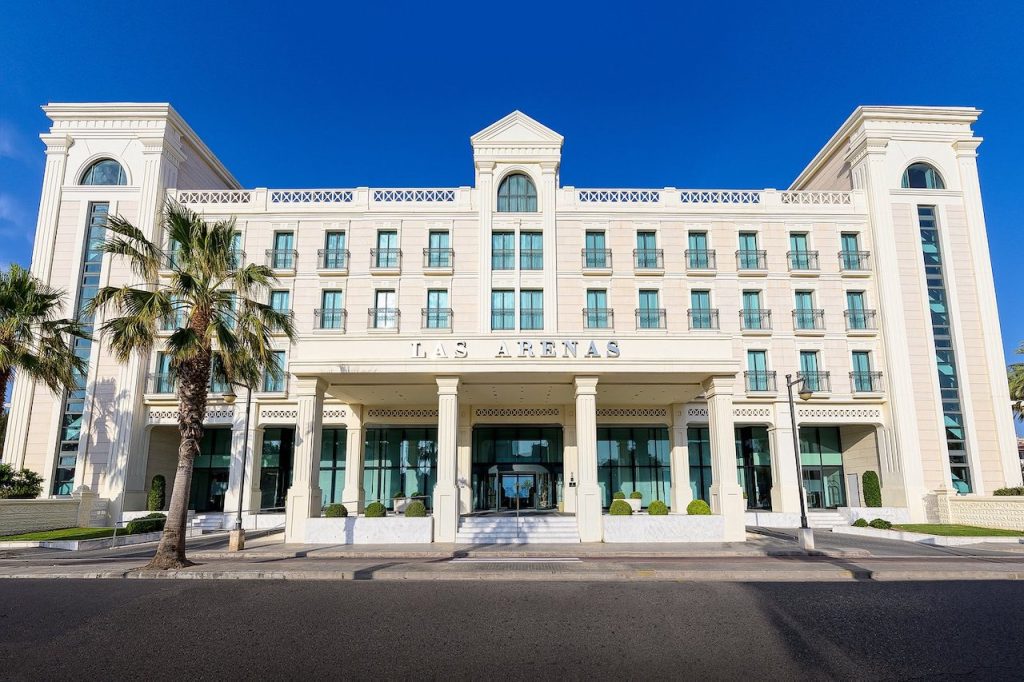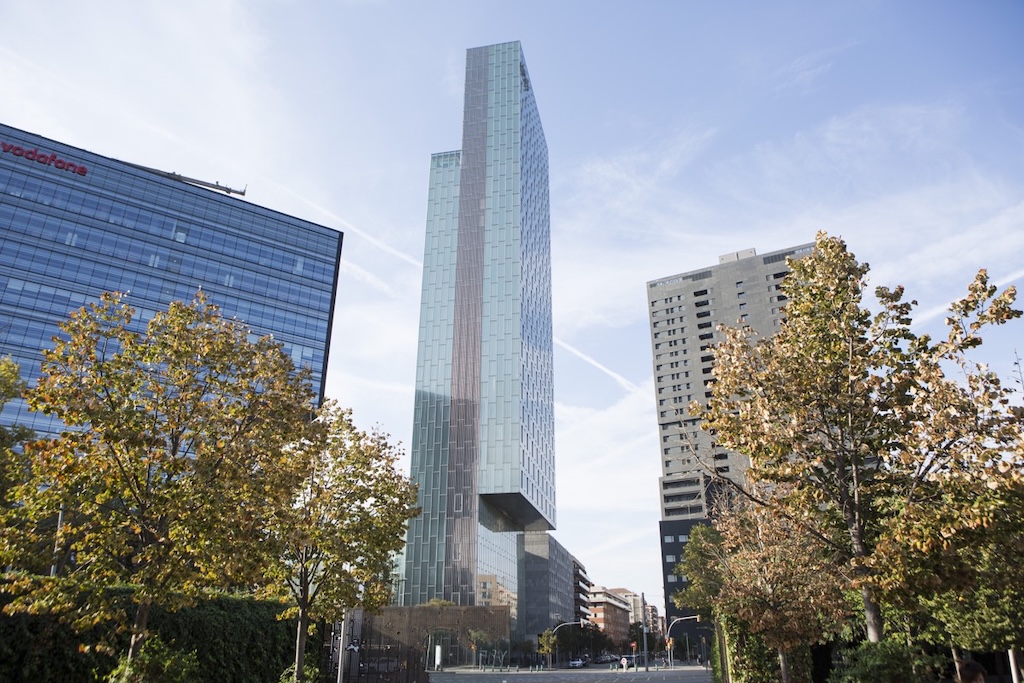Why post about backpacks for laptops?
I’ve carted stuff around in a variety of suitcases, bags and backpacks, and not really thought too much about it. Over the last 15-20 years my wife and I travelled a lot by car, we had a small roller/spinner or two, she had her vanity case (sometimes called a train case), and I had some type of holdall, small bag, or backpack just to take stuff from the car to the hotel, etc. That stuff included a laptop, money, credit cards, keys, travel and ID documents, charger and cables, etc., all to go in the hotel room wall-safe.
In 2024 on a short hop flight I just took a “hand luggage” roller and a small bag. In the bag I put the usual stuff, plus my laptop. It was pain, pulling the roller with one hand and carrying the small bag with the other. The bag just wouldn’t stay-put on the roller. For the security control it was pain to extract the flat rectangular slab (my laptop) from a small bag with a single narrow zip. I kicked myself for not taking my lightweight backpack.
Since I’m planning some major long-haul flights in the next few years I thought it might be time to look again at getting a decent backpack for the modern day traveller.
But what constitutes the perfect backpack?
Everyone has had a backpack sometime in their lives
As a teenager I had a fantastic washed-out dirty orange waxy-feeling fabric rucksack with a lightweight aluminium frame. It was German (possibly based on a military design), and my uncle gave it to me, along with the skin and head of a wolf to protect it. My Dad put the tatty-looking wolf skin in the bin (and quite rightly too), but I could put my whole life in that rucksack.
The rucksack itself was quite heavy, however the frame was ultra-lightweight. The whole was ultra-strong, and the padding, shoulder and waist straps were really comfortable. It was said that someone could actually climb on the frame, and be carried. Never tried it. The backpack itself was very simple, quite thin and tall, no external pockets, no interior separators, and no zips, just a cover flap with two short leather straps. I know it went to Italy with me in 1974, but I can’t remember what happened to it after that. It’s possible it went to live in Germany with me in 1978, and never came back.
When I got my first “important” job in 1981 I splashed out and bought a Samsonite hard-shell briefcase with key and combination lock. I travelled a lot, and that briefcase went with me everywhere. It was very solid, but I never really liked it. I’ve always hated not having both hands free.
What changed was when laptops appeared. I had seen and played with the Osborne 1, the Compaq Portable, and even the Macintosh Portable, but my first laptop was a Sony Vaio (1996). I had changed jobs in 1993, and suddenly I started to meet people who had portable computers, or even PowerBooks. When the Vaio appeared, its size and weight were perfect for me (I would later migrate to Apple, first with an iBook then MacBook Pro’s). With the laptop came the need for a backpack.
In meetings everyone (young, like mid-30’s) started to have laptops and backpacks. Every meeting started with unpacking, plugging-in, booting-up, and checking the connection to the projector system. I remember noting that the older, more experienced IT specialists, still brought with them “viewfoils” or “transparencies” to be used with overhead projectors. These “oldies” came with a scientific background, and had always used viewfoils or slides. And they “knew” that the IT infrastructure was unpredictable, and often no one knew how that particular projector system worked. Meetings often started late because no one knew how to set-up the projector, no one knew who was responsible for it, and if they knew who was responsible, he was inevitably somewhere else.
In the “early days”, what was even more amazing was that managers with no scientific or IT background, were so easily impressed when someone turned up with a backpack, a laptop, and presentation software “out-of-the-box” (and no tie and jacket).
Back to backpacks
Through my working life I collected well over 30-40 different types of document pouches, briefcases, backpacks, bags, sacks, etc., many given as part of a conference or symposium pack. Some poor quality, some made by prestigious names, some labelled with the conference title, etc.
I also bought a few backpacks and shoulder bags myself, some too large when full, some too small, and a few just right, but of poor quality.
I have over the years kept just five of these bag-backpacks (all with options shoulder straps). Three were freebies and two I bought myself.
The first is a legal-style document case from Munari. It’s a very well made large format (40x28x10) document-style case. But it only has two compartments and no protection for a laptop.
The second is a document-style laptop case from Marware. This provides excellent protection for a laptop, but space is very limited. I’ve kept both in perfect condition, because I’ve never used them. But I keep them, and despite being over-70, I still live in hope.
I bought the third, a Case Logic Notion-like, brief-case-style laptop bag. It has padded compartments for more than one laptop, a separate pocket for a tablet, a separate section with multiple storage options for small electronics, cords, accessories, business cards and keys, a quick access zippered pocket at the front (for tickets, etc.), and both grab handles and a removable shoulder strap. I’ve had this quite some time, but it’s the version without the pass-through strap for a roller. This third bag is used for carrying all my important stuff whilst driving. It’s easy to carry up to a hotel room, and can contain all the stuff I want to put in a wall-safe.
I also bought my fourth, and it’s a real backpack-looking backpack from Targus. It has two very spacious sections with lots of internal pockets, etc. It has a very well padded back, good shoulder straps, a document pouch, a space for a water bottle, and even a space reserved for shower sandals. The main problem is that I can put more stuff in it than in the Case Logic laptop bag mentioned above, but then it gets very heavy. It’s really “old-style”, and I could have once lived out of it for weeks (just clothes, washing stuff and an old-style razor), but now we have laptops, phones, and hundreds of chargers and cables. With an 7-8 kg limit on hand luggage, it’s too big for its own good.
The fifth and last bag is a backpack sponsored by IBM and given out at a conference in 2001. It is really designed as a computer backpack and I’ve always used it when flying (except once as mentioned above). It’s been around the world twice. It is quite robust, but at the same time surprisingly light. The back and straps are well padded, and the straps can be folded away in a zip compartment at the back. It is divided into two separate parts with separate zip openings. In one there is a single well protected compartment for a laptop with straps (my laptop has its’ own silicon pouch as well), and a second compartment. The other part with a separate zip is divided into three simple compartments. There is a pull-over flap with two snap locks, and on the front there is a decent document pouch with velcro.
I’ve since then said goodbye to the Munari, Marware and the Targus.
Today I think my IBM-sponsored backpack is the one to beat.
Can we define what a good laptop backpack should be?
One review kicked off with “It’s more ergonomic than a tote or messenger bag, it holds more than a briefcase, and it looks more stylish than a rolling bag”.
So what’s a tote bag? According to Wikipedia it’s a a large, typically unfastened bag with parallel handles that emerge from the sides of its pouch. They say it’s a bit like a reusable shopping bags. Well I’m not putting my computer, passport, tickets, spare cash, etc. in a tote bag!
And, again according to Wikipedia, a messenger bag (also called a courier bag, and maybe even a carryall or a sling bag depending upon the size) is a type of sack, usually made of cloth (natural or synthetic). It is worn over one shoulder with a strap that goes across the chest resting the bag on the lower back. Apparently they are now also an urban fashion icon. So I have two good reasons for giving this another fat No! Put all my valuables in a “sack” and then have someone steal it because it’s an icon. No thank you!
On top of that, it reminded me of a satchel. And I’ve still got mine from primary school.
Forget the briefcase. Been there, done that.
And the rolling bag, is just a type of rolling luggage, and totally inappropriate as a surrogate laptop backpack.
In this article they tested 75 backpacks on buses, trains, cars, bikes, and planes. And they picked the best tailored professional bag, a tough pack that fits a ton of tech, a sleek travelling companion, a stylish and budget-friendly option, and an ergonomic office-to-gym workhorse.
They defined the first one as “think modern-briefcase vibes”. So that was big, fat No, I hate briefcases.
The second one was quite big and had a “paradise of pockets”, and that meant it was able to carry a lot of stuff, and would end up being too heavy. For me a backpack should be able to carry enough, but not too much. There must be a constraint that forces the owner to only take what is necessary, and not cart along the kitchen sink.
The third one was a “sleek travelling companion“, and it caught my attention because it looked the right size (20 litres), it was water resistant, and it fitted “securely on the handle of a rolling suitcase”. The article went on to note that the main compartment had a tablet sleeve and a sleek zippered pouch. Against the back of the pack there was a top-zip laptop compartment for computers up to 16 inches, while a roomy quick-access front pocket provided a place to stash smaller items. And the article mentioned that the limited size meant that it wouldn’t tempt the owner to overpack. The only real downside identified was that this bag didn’t have air-mesh back panels, so it wore a little hotter.
The fourth one a stylish and budget-friendly option scored well. Good that it was suited to medium loads, was water resistant, and proved to be simple, sturdy and inexpensive. They did mention that the computer was accessed through the side, and not the top. So I would need to see exactly what that meant in real life, before deciding.
The last of the five was the one for “fitness-minded folks who hit the gym before or after work”. So it’s a No, because I don’t work.
So how did the “sleek travelling companion” compare to my IBM sponsored backpack, which I’ve used a lot since 2001?
The article described the “sleek companion” as being 40x28x16.5 cm,, with a volume of 20 litres. However, those dimensions don’t make 20 litres, but only 18.5 litres. My old IBM bag is slightly wider and a bit thinner, and has a total volume of 18.7 litres (including the front pocket). It is slightly simpler inside, but the laptop compartment actually opens up completely and has straps, and there is a pull-over flap with two snap locks. This makes it more difficult to access the content when the flap is snapped closed. So a bit more work to get the laptop out for security inspection in airports, but more secure when hanging on my back.
Frankly, I can’t see any major advantage to replacing my old IBM sponsored backpack.
Next up was another article which picked the five best from 40 laptop backpacks (the Editor’s Choice was the same as one found in the tests mentioned above). However, for me only two were interesting because the others were too big (30 to 50 litres capacity). Of those two, one was seen as not being a good travel bag, and the other was too expensive.
I went on to read quite a number of other reviews, but I couldn’t find one that stood out as being significantly better than my old IBM backpack.
What does my laptop backpack look like?
I understand perfectly those who want a 30-40 litre backpack with dry and wet compartments, and space for some overnight clothes, etc., as well as carrying documents and a laptop with charger, cables, etc.
But when I fly or drive I have a carry-on spinner, so my focus is on a backpack that carries “my life”, i.e. ID, keys, documents, tickets, valuables, laptop, iPad and phones (plus charges and cables).
Below is my easy to carry backpack, and remember it was free, and dates from from a conference in 2001. In my travels I’ve actually seen (but not met) two people with the same backpack from the same event.


Above we can see the pull-over flap and the two snap locks, which protects access to the compartments. On the front there is a good size (around 3 litres) pouch with a really hard and noisy velcro. The back and straps are reasonably well padded, and the straps can be unhooked and folded away in a zip compartment at the back. It’s also important that the straps can be contracted or extended to accommodate both light summer clothes and heavy winter ski-type padded clothes.
My backpack is divided into two separate parts with separate zip openings. As seen below one compartment opens 180° and has a single well protected section for a laptop with straps (my laptop has its’ own silicon pouch as well), There is a second separate section to this compartment. In there I have a series of small flat pouched for charges, cables, valuables, keys, spare glasses, etc.
The second compartment only opens partially, but has three sections that can easily take three document folders, etc. Occasionally it has taken a change of shirt and underwear, and accessories for an overnight in a hotel (I have compression bags of different sizes that fit perfectly).
The front pouch is big enough (over 3 litres) to hold my iPad in its silicon pouch, ID and travel documents, a thinnish paperback, some wipes, and even a pair of sunglasses, etc.

The one feature that I would have liked to have, is the possibility to slide it onto the handle of my spinner. Having a handle on the top does help. I can sit the backpack on top of the spinner and hold both together with one hand, but it’s not perfect.
And what about bags?
Just a comment about bags. Somehow over the years we acquired a number of carry-style bags. Simple things, with a zip, handles and an over-the-shoulder strap.
We still have a simple 20-litre green canvas “golfers” bag that we received from a US golf hotel in 1992.
We also still have four Mercedes bags that came with a sport-cargo roof box we once had. The box has long gone, and since then we have never used the bags, but I can’t bring myself to get rid of them.
We have four simple 25-litre red Nike sports bags, which we bought new about 10 years ago as a discount-pack on eBay. We use them when travelling in the car. They are just perfect. Not too big, so not too heavy, and they are kind of modular and pack well in the boot along with one or two small suitcases.
We have an ultra-lightweight polyester-polyamide 30-litre Desigual bag, which we received in Italy when buying some sheets. It is very light, folds really small, and we take it with us as an emergency bag, just in case.
Once when travelling the handle of my wife’s Samsonite vanity case broke. It could not be repaired, and amazingly we could not find any vanity cases in Thailand. So my wife bought a 15-litre Samsonite shoulder bag for all her travel “stuff”. The old vanity case was a pain because it did not hold enough “stuff” for her, but the Samsonite bag was/is a pain for me, because it holds too much “stuff”.
Last, but not least, we have a 45-litre Chinese Nike knock-off sports bag. In theory very practical and useful, but in reality just too big.
Now that my beloved Monique has passed away, my travel arrangements have changed, and most of these bags have gone to better homes.










